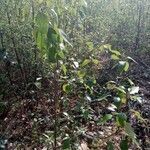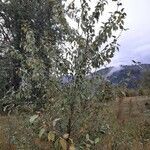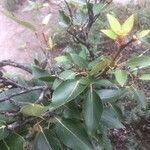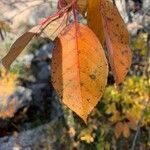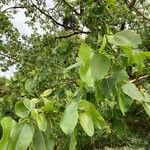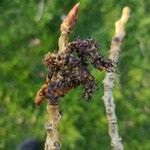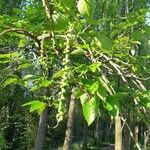Plants to 40 m, 21 dm diam.; weakly heterophyllous. Bark reddish gray, furrowed. Branchlets reddish brown, becoming grayish brown by third year, round, 1.5-3.5(-5) mm diam., coarse, glabrous or glabrate to densely hairy. Winter buds reddish, glabrous, resinous (resin red, abundant, very fragrant, balsamic); terminal buds (8-)12-16(-20) mm; flowering buds clustered distally on branchlets, 15-19 mm. Leaves: petiole cylindrical or distally slightly flattened in plane of blade, (0.2-) 1.5-5 cm, 1/3-1/2 blade length (usually glabrous); blade usually narrowly ovate to ovate, rarely broadly ovate, (2.5-)5-9(-15) × (0.7-)3-5.5(-9) cm, w/l = 1/2-2/3, base rounded to broadly cuneate or subcordate, basilaminar glands 0 or 2(-5), round, margins not translucent, not ciliate, apex obtuse to acute, abaxial surface often with reddish orange resin stains, glaucous, (veins prominent), adaxial dark green, glabrous; preformed blade margins subentire to very finely, evenly crenate-serrate throughout, teeth (9-)20-35(-45) on each side, sinuses 0.1-0.4 mm deep; neoformed blade margins finely crenate-serrate throughout, teeth (20-)30-45 (-60) on each side, sinuses 0.2-0.6 mm deep. Catkins moderately loosely (35-)50-70(-80)-flowered, 7.5-15(-18 in fruit) cm; floral bract apex deeply cut, not ciliate. Pedicels 0.5-2(-3.5 in fruit) mm. Flowers: discs shallowly cup-shaped, not obviously oblique, entire, 2-3(-4) mm diam.; stamens 20-30; anthers truncate; ovary 2-carpelled, ovoid to spherical; stigmas 2-4, platelike, expanded, reflexed. Capsules ovoid, (3-) 5-8 mm, glabrous, 2-valved. Seeds 15-22 per placenta. 2n = 38.
More
Tall tree with dark gray furrowed bark and glabrous or hairy twigs; terminal buds glabrous, viscid; petioles ± terete; lvs resinous, ovate to lance-ovate, acute or short-acuminate, finely serrate or subentire, cuneate to rounded or subcordate at base, glabrous, dark green above, white and glaucous (often streaked with orange resin) beneath; scales of the catkins long-ciliate; stamens 20–30; stigmas 2, nearly sessile, broadly dilated; frs ovoid, 2-valved, 5–8 mm, crowded on short pedicels, forming a compact, spike-like raceme; seeds 15–22 per placenta; 2n=38. Wet woods, river-banks, and shores; Lab. to Alas., s. to Conn., n. Pa., n. Ind., n. Io., Nebr., and Colo. (P. tacamahacca)
A medium sized deciduous tree. It grows 25-30 m high. The trunk is 50 cm across. The bark is grey and ridged. The leaves are oval and 12 cm long by 10 cm wide. They taper to a point. They have fine teeth. They are glossy green above and white with net veins underneath. The sexes are separate. Male catkins are reddish. Female catkins are followed by small green fruit carried in masses of white cotton-like threads.
